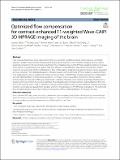Optimized flow compensation for contrast-enhanced T1-weighted Wave-CAIPI 3D MPRAGE imaging of the brain
Author(s)
Tabari, Azadeh; Lang, Min; Awan, Komal; Liu, Wei; Clifford, Bryan; Lo, Wei-Ching; Splitthoff, Daniel N.; Cauley, Stephen; Rapalino, Otto; Schaefer, Pamela; Huang, Susie Y.; Conklin, John; ... Show more Show less
Download41747_2023_Article_351.pdf (1.606Mb)
Publisher with Creative Commons License
Publisher with Creative Commons License
Creative Commons Attribution
Terms of use
Metadata
Show full item recordAbstract
Abstract
Flow-related artifacts have been observed in highly accelerated T1-weighted contrast-enhanced wave-controlled aliasing in parallel imaging (CAIPI) magnetization-prepared rapid gradient-echo (MPRAGE) imaging and can lead to diagnostic uncertainty. We developed an optimized flow-mitigated Wave-CAIPI MPRAGE acquisition protocol to reduce these artifacts through testing in a custom-built flow phantom. In the phantom experiment, maximal flow artifact reduction was achieved with the combination of flow compensation gradients and radial reordered k-space acquisition and was included in the optimized sequence. Clinical evaluation of the optimized MPRAGE sequence was performed in 64 adult patients, who all underwent contrast-enhanced Wave-CAIPI MPRAGE imaging without flow-compensation and with optimized flow-compensation parameters. All images were evaluated for the presence of flow-related artifacts, signal-to-noise ratio (SNR), gray-white matter contrast, enhancing lesion contrast, and image sharpness on a 3-point Likert scale. In the 64 cases, the optimized flow mitigation protocol reduced flow-related artifacts in 89% and 94% of the cases for raters 1 and 2, respectively. SNR, gray-white matter contrast, enhancing lesion contrast, and image sharpness were rated as equivalent for standard and flow-mitigated Wave-CAIPI MPRAGE in all subjects. The optimized flow mitigation protocol successfully reduced the presence of flow-related artifacts in the majority of cases.
Relevance statement
As accelerated MRI using novel encoding schemes become increasingly adopted in clinical practice, our work highlights the need to recognize and develop strategies to minimize the presence of unexpected artifacts and reduction in image quality as potential compromises to achieving short scan times.
Key points
• Flow-mitigation technique led to an 89–94% decrease in flow-related artifacts.
• Image quality, signal-to-noise ratio, enhancing lesion conspicuity, and image sharpness were preserved with the flow mitigation technique.
• Flow mitigation reduced diagnostic uncertainty in cases where flow-related artifacts mimicked enhancing lesions.
Graphical Abstract
Date issued
2023-07-03Department
Harvard University--MIT Division of Health Sciences and TechnologyPublisher
Springer Vienna
Citation
European Radiology Experimental. 2023 Jul 03;7(1):34
Version: Final published version